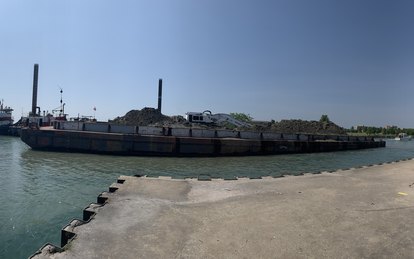Settling Sediment Issues in the Great Lakes

Image: StartDredging.com
Cities and state and federal regulators have long agreed that harbors and navigational channels must be dredged to keep the boat traffic flowing and maritime economies flowing. Starting in 2013, however, the City of Cleveland and the U.S. Army Corps of Engineers developed an ongoing disagreement over what to do with the resulting dredged sediment, particularly when it is contaminated, and the existing containment dikes are running out of storage space. While their legal dispute was officially settled last year, it provides an important benchmark that is likely to inform future regulations addressing safe disposal of dredged sediment in the Great Lakes.
The City and the State of Ohio had demanded that the Army Corps dispose of sediment dredged from the Cuyahoga River shipping channel into containment dikes instead of a few miles offshore directly into Lake Erie. The City and the State argued that the open-water disposal of this sediment adversely harms the lake's water quality and ecosystem, while the Corps argued it did not.
At issue was the sediment dredged out of the sixth mile of the Cuyahoga River downstream from Lake Erie, near where the ArcelorMittal steel mill operates. Concerned that this sediment was contaminated, the City filed suit and the court ruled in its favor. That State of Ohio has also banned open water disposal of dredged material in Lake Erie starting in 2020.
This dispute highlights the divergent cost priorities that inform positions on dredged sediment disposal, and the need to better capture environmental impacts and benefits in cost-benefit ratios. These ratios tend to focus on minimizing the cost of the ongoing maintenance versus committing to the costs required to improve and protect the environmental future of Lake Erie.
Open water disposal often represents the best alternative for the USACE based on the cost-benefit ratio that drives much of their decision making. As a mandate the USACE must determine the best alternative for disposal of dredge material, taking into consideration the cost of dredging along with its impact and benefits. However, the methods used to capture environmental benefits from activities such as beneficial reuse are difficult to convert into dollar values. This results in open water disposal often being calculated as the best available alternative.
The ultimate solution to this issue could end up being more technical than legal. The Port of Cleveland has helped develop an innovative interceptor device that sucks up clean excess sediment headed downstream before it reaches the contaminated section of the river. This allows that sediment to be reused instead of disposed of, at a significantly lower cost to all parties involved. It costs the Corps $17 per cubic yard to surface-dredge sediment from the shipping channel; it only costs about $1 per cubic yard to collect that sediment with the Port’s river-bottom interceptor device before it reaches the channel.
If more of this sustainable dredging technology can be brought online, the resulting savings could provide a way to control dredging costs in the face of tighter federal budgets while significantly reducing or phasing out the need for open-water disposal practices.